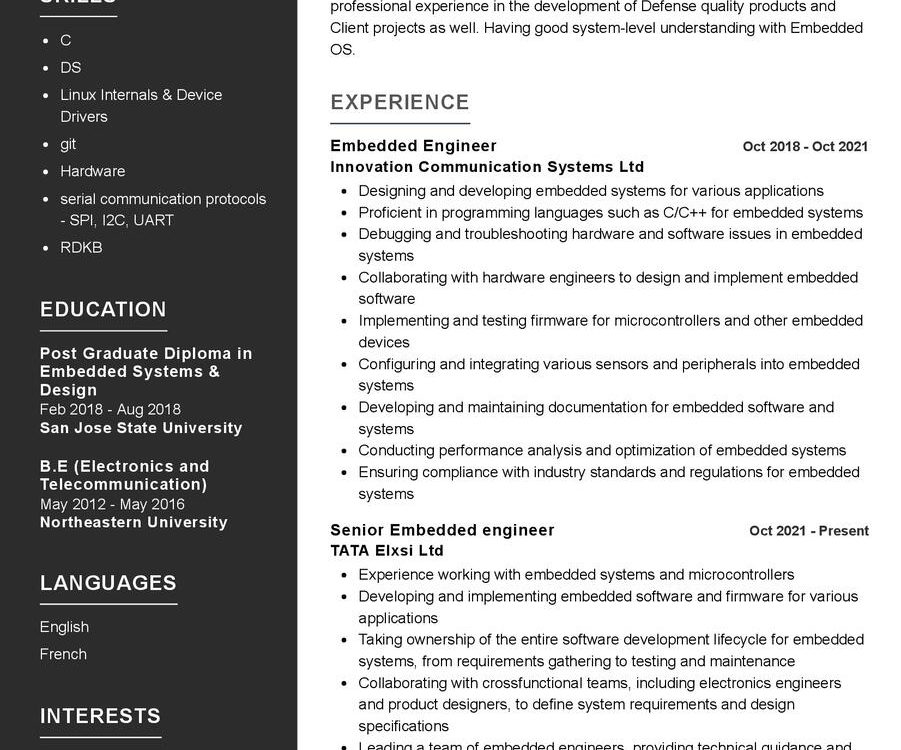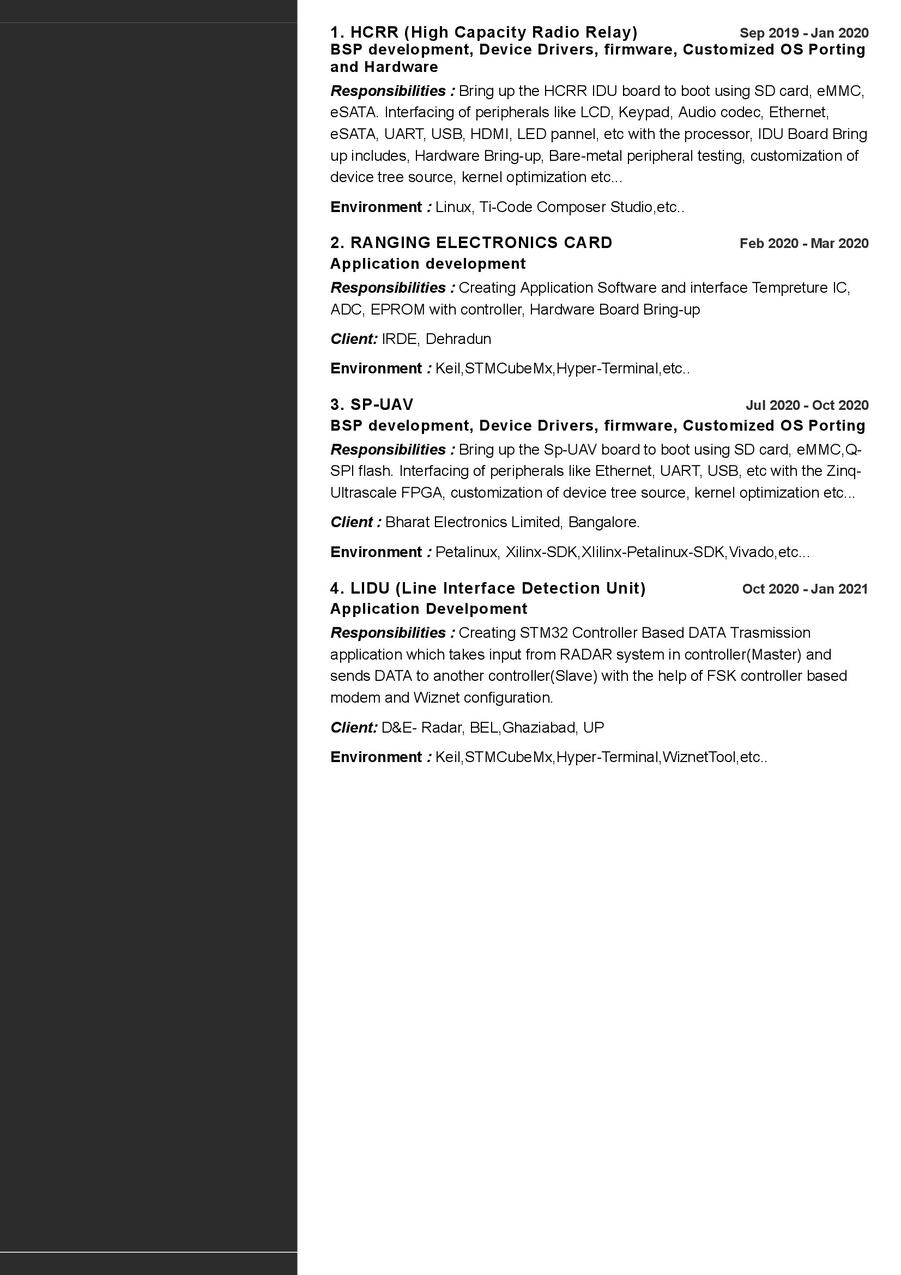Exploring the Role of an Embedded Engineer
As technology advances at a rapid pace, the demand for skilled professionals in fields like embedded engineering has never been higher. The position of an Embedded Engineer plays a critical role in designing and developing embedded systems, contributing to the innovation and efficiency of various industries. In this comprehensive guide, we will delve into the multifaceted role of an Embedded Engineer, the qualifications needed, key responsibilities, and tips on crafting an effective Embedded Engineer CV.
Requirements for an Embedded Engineer Position
Becoming an Embedded Engineer requires a specific set of skills and qualifications. Let’s explore the educational and experiential prerequisites that pave the way for a successful career in embedded engineering:
- A Bachelor’s or Master’s degree in Electrical Engineering, Computer Engineering, or a related field, showcasing a solid foundation in the technical domain.
- Proficiency in programming languages like C, C++, and assembly language, essential for embedded systems development.
- Hands-on experience with microcontrollers and microprocessors, demonstrating practical knowledge in hardware-software integration.
- Familiarity with real-time operating systems (RTOS) and embedded software development tools.
- Strong problem-solving skills, the ability to troubleshoot and debug complex embedded systems.
- Excellent communication skills to collaborate with cross-functional teams and effectively convey technical information.
Securing additional certifications in relevant technologies such as ARM architecture or FPGA programming can enhance your profile in the competitive job market.
Key Responsibilities of an Embedded Engineer
The role of an Embedded Engineer is dynamic and involves a range of responsibilities. Let’s break down the core tasks that define this role, showcasing the depth and diversity of an Embedded Engineer’s contributions:
- Designing and developing embedded systems architecture, considering hardware and software constraints.
- Programming microcontrollers and microprocessors, ensuring seamless integration of embedded software with hardware components.
- Conducting testing and debugging of embedded systems to identify and resolve issues in a timely manner.
- Collaborating with cross-functional teams, including hardware engineers and software developers, to achieve project goals.
- Staying updated with emerging technologies and industry trends in embedded systems development.
- Documenting design specifications, creating technical documentation for reference and future development.
- Participating in the full product development lifecycle, from concept to deployment.
Each responsibility comes with its own set of challenges and learning opportunities, contributing to the overall growth of an Embedded Engineer.
Crafting an Effective Embedded Engineer CV
Your Embedded Engineer CV is a crucial tool in presenting your qualifications and experiences to potential employers. Here are some tips to help you create a compelling CV tailored for the embedded engineering position:
- Highlight your hands-on experience with specific microcontrollers and processors, showcasing your technical expertise.
- Detail any significant projects you have worked on, emphasizing your contributions and achievements.
- Include metrics to quantify your impact, such as improvements in system efficiency or successful project completions.
- List relevant certifications, demonstrating your commitment to continuous learning and skill development.
- Customize your CV for each application, aligning your skills and experiences with the specific job requirements.
Your CV is more than a document; it is a reflection of your journey, your skills, and your potential as an Embedded Engineer.
Embedded Engineer CV Summary Examples
Your CV summary serves as the introduction to your professional story. Craft a powerful summary that encapsulates your experiences, skills, and the value you bring to the table. Here are some examples to inspire you:
- “Experienced Embedded Engineer with a track record of designing and implementing robust embedded systems, proficient in C and C++, and adept at collaborating with cross-functional teams for successful project outcomes.”
- “Results-driven Embedded Engineer with a passion for innovation, skilled in programming microcontrollers and troubleshooting embedded systems, with a proven ability to meet project deadlines.”
- “Detail-oriented Embedded Engineer with expertise in real-time operating systems and a history of successful product development, committed to staying ahead in the ever-evolving field of embedded systems.”
Your CV summary is a glimpse into your career, offering a preview of your skills, experiences, and potential contributions as an Embedded Engineer.
Building a Strong Experience Section for Your Embedded Engineer CV
Your experience section is the core of your CV, narrating your career journey and showcasing your growth. Here are some examples to guide you in creating a robust experience section:
- “Led the development of an embedded system for XYZ product, resulting in a 15% improvement in overall system performance.”
- “Collaborated with a multidisciplinary team to troubleshoot and resolve complex issues in embedded systems, ensuring timely project completion.”
- “Contributed to the design and implementation of a real-time operating system, enhancing the efficiency and responsiveness of embedded systems.”
Each experience is a chapter in your career story, highlighting your contributions, problem-solving abilities, and successful project outcomes.
Education Section for Your Embedded Engineer CV
Your educational background is a testament to your knowledge and expertise. Here’s how you can present your educational milestones in your CV:
- Master of Science in Electrical Engineering, ABC University, a journey of in-depth learning and specialization, 2019.
- Bachelor of Science in Computer Engineering, XYZ University, the foundation of your career in embedded systems, 2015.
- Certified Embedded Systems Professional (CESP), a recognition of your expertise in embedded systems development, 2020.
Each educational qualification is a building block, contributing to the depth of your knowledge and skills as an Embedded Engineer.
Essential Skills for an Embedded Engineer CV
Your skill set is a valuable asset, showcasing your ability to navigate the complexities of embedded systems development. Let’s list down the essential skills that an Embedded Engineer should possess:
Technical Skills:
- Proficiency in programming languages such as C, C++, and assembly language.
- Hands-on experience with microcontrollers and microprocessors.
- Familiarity with real-time operating systems (RTOS) and embedded software development tools.
- Debugging and troubleshooting skills for identifying and resolving issues in embedded systems.
- Knowledge of hardware-software integration principles.
Soft Skills:
- Effective communication and interpersonal skills for collaboration with cross-functional teams.
- Problem-solving abilities to address challenges in embedded systems development.
- Attention to detail, ensuring precision in the design and implementation of embedded systems.
- Adaptability and a commitment to staying updated with industry trends and emerging technologies.
Each skill is a tool in your toolkit, essential for success in the dynamic field of embedded engineering.
Common Mistakes to Avoid When Writing an Embedded Engineer CV
Crafting an effective CV requires avoiding common pitfalls that can hinder your chances of landing your dream job. Here are some mistakes to steer clear of:
- Avoid using a generic CV for all applications; tailor your CV to highlight specific skills and experiences relevant to each job.
- Avoid listing only job duties; instead, showcase your achievements and contributions in each role.
- Don’t underestimate the importance of a well-crafted cover letter to complement your CV and provide additional context to your application.
- Avoid excessive use of technical jargon; ensure your CV is accessible to both technical and non-technical readers.
- Always proofread your CV to avoid typos and errors that can impact your professional image.
Avoiding these mistakes will help you craft a CV that is both authentic and compelling, increasing your chances of standing out to potential employers.
Key Takeaways for Your Embedded Engineer CV
As we conclude this comprehensive guide, let’s recap the key points to keep in mind while crafting your Embedded Engineer CV:
- Emphasize your hands-on experience and technical proficiency, showcasing your ability to contribute to embedded systems development.
- Highlight specific achievements and contributions in each role, quantifying your impact where possible.
- Customize your CV for each application, aligning your skills and experiences with the specific job requirements.
- Include a section on continuous learning, showcasing relevant certifications and training programs undertaken.
Finally, feel free to utilize resources like AI CV Builder, CV Design, CV Samples, CV Examples, CV Skills, CV Help, CV Synonyms, and Job Responsibilities to create a standout application and prepare for the Embedded Engineer job interview.
Armed with these insights and tips, you are now ready to craft a CV that is a true reflection of your journey, your skills, and your aspirations. Remember, your CV is not just a document; it is a canvas where you paint your career story, a story of growth, learning, and success. Best of luck!



